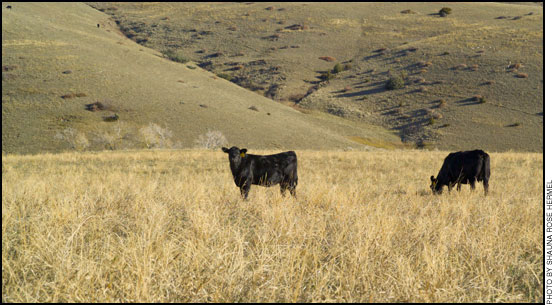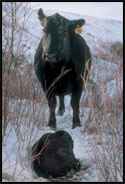HEALTH & NUTRITION...

Re-think Heifer Development
ARS researchers say a different approach to feeding replacement heifers could save $31 per heifer in development costs and extend their average lifespan.
Reducing the amount of feed given to heifers can result in more efficient use of nutrients for growth and reproduction, according to studies conducted by U.S. Department of Agriculture (USDA) scientists. Agricultural Research Service (ARS) Animal Scientist Andrew Roberts and his colleagues at the Fort Keogh Livestock and Range Research Laboratory in Miles City, Mont., found that the heifers they fed to lower target weights than those traditionally recommended consumed 27% less feed over the winter months and gained weight more efficiently throughout the postweaning period and subsequent grazing season.
According to Roberts, this strategy of providing less feed may reduce costs of developing each replacement heifer by more than $31 and extend their lifespan, with important ramifications for lifetime efficiency and profitability. Read more.
 Feeling the Chill
Feeling the Chill
Calves that become too chilled at birth, without immediate assistance to warm and dry them and to make sure they ingest colostrum in a timely manner, have poor survival rates. Newborn calves can handle relatively cold temperatures, notes Russ Daly, South Dakota State University Extension veterinarian. But if there's wind and precipitation, it can be a different story. Those calves on the edge of hypothermia are the hardest to distinguish, says Daly. Read more.
Calf Warming Boxes
A hot tub in the house, a hot box or a warm corner in the barn … When a little added warmth means the difference in life or death to a newborn, just about any place you can get the calf into to add a little warmth seems a help. But there are cautions one should take so as not to foster problems down the road. South Dakota State University Extension Veterinarian Russ Daly shares some precautions for calf warming boxes. Read more.

Rick Rasby
Ridin’ Herd
Using salt to limit intake
Cattlemen continue to investigate ways to reduce cow costs. Standardized Production Analysis (SPA) and Integrated Resource Management (IRM) records indicate labor costs affect annual cow costs. Management strategies to reduce cow costs, in particular labor costs, would increase profit potential of the cow-calf enterprise.
One management tool frequently used is regulating feed intake with salt. Research would suggest that regulating feed intake with salt is not precise, meaning the salt content may need to be adjusted throughout the feeding period to achieve the desired feed intake. As a management practice, self-feeding supplements tends to allow timid, slow-eating cows to get their share, and it is an easy method of providing vitamin A, phosphorus (P) and other feed additives. Read more.
Put to the Test
UK corn silage variety trials can aid in 2011 planting decisions.
The results of the 2010 University of Kentucky (UK) Corn Silage Variety Trials are out.
"Farmers are looking for data to predict next year's performances, and the best way to do this is to look at a variety's yield data over several years … in several different locations," said Chad Lee, grain crops extension specialist in the UK College of Agriculture. Read more.
Are RFI, Tenderness Connected?
ISU researchers look at how RFI affects pork quality.
Pork producers are also eyeing residual feed intake (RFI) as a means of improving production efficiency and producer profitability. Recently reported research from Iowa State University (ISU) in the Journal of Animal Science may pose a caution to beef producers targeting high-quality beef. An article submitted by S.M. Lonergan (J. Anim. Sci. 2011. 89:192-200) suggests selection for decreased RFI can have corresponding changes in pork quality. Read more.
Johne's Newsletter Available
The National Johne's Education Initiative has released its spring issue of the beef Johne's Disease newsletter developed for beef producers. The educational effort is funded by the the Veterinary Services division of the U.S. Department of Agriculture Animal and Plant Health Inspection Service (USDA-APHIS-VS).
This issue contains "Johne's Disease: What You Need to Know, Part I" and "Vaccine Project in Phase 2." Download the newsletter.
To learn more about Johne's disease prevention and control, please contact your state designated Johne's coordinator (DJC). A list of state DJCs is available online at www.johnesdisease.org.
Cattle Diseases: Common Conditions/Terms
Click here for a list of common conditions and terms related to beef cattle diseases, such as anaplasmosis, brucellosis, BVD, E. coli, IBR and others.
[Click here to go to the top of the page.]





